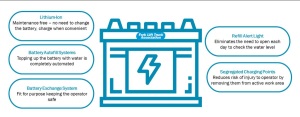Forklift news
The largest forklift operator training website in the world
![]()
![]()
FLTA safety drive - week five. Battery maintenance

This week’s safety topic is battery maintenance. It is important for the safety of your operators to choose the most appropriate forklift trucks and corresponding battery system and ensure safe working practices are maintained.
Lithium ion
- Maintenance free so there is no need for the operator to change the battery, reducing the risk of injury through handling
- No leaking of hazardous battery gases and acids which is particularly suitable for use in areas where a high degree of sensitivity is required such as the pharmaceutical and food industries.
- It can be charged at a convenient time, reducing downtime in the operation
- Up to 30% more energy due to higher energy density and high overall system efficiency
- No loss of performance even with decreasing battery charge increasing productivity
- Battery can be recharged even during short breaks, meaning costly and time-consuming battery changes are not necessary
- Particularly useful in intensive applications such as multi-shift operation and refrigerated storage
Acid based batteries
- A refill alert light highlights when the water level is low, eliminating the need for the operator to open it up to check
- Battery Autofill systems fully automate the water refill process
- A battery exchange system which is fit for purpose ensuring the battery is safely removed and replaced
- Only trained personnel should perform forklift battery charging and battery changing. Everyone assigned to charging tasks should be trained in accident prevention and emergency management
- Wear the appropriate PPE when changing a battery including safety goggles, face shields, rubber or neoprene gloves and aprons to protect from injury
Segregated Charging Points
- OSHA regulations require all battery charging tasks to take place in a specifically designated area
- It needs to be appropriately ventilated so that fumes and gases generated in the charging process don’t accumulate to dangerous levels
- Protect all battery handling equipment from collisions by surrounding them with highly visible structural barriers
- Battery room floors should be level, flat and acid-resistant
- The room should have access to plenty of water for neutralizing electrolyte spills and flushing burns